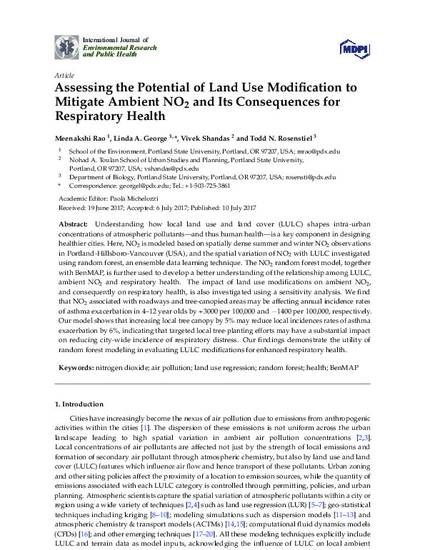
- Emission density zoning,
- Nitrogen dioxide -- Environmental aspects,
- Atmospheric nitrogen dioxide -- Oregon -- Portland Metropolitan Area -- Mathematical models,
- Atmospheric nitrogen dioxide -- Washington (State) -- Vancouver Metropolitan Area -- Mathematical models,
- Urban forestry -- Environmental aspects,
- Trees in cities -- Environmental aspects
Understanding how local land use and land cover (LULC) shapes intra-urban concentrations of atmospheric pollutants—and thus human health—is a key component in designing healthier cities. Here, NO2 is modeled based on spatially dense summer and winter NO2 observations in Portland-Hillsboro-Vancouver (USA), and the spatial variation of NO2 with LULC investigated using random forest, an ensemble data learning technique. The NO2 random forest model, together with BenMAP, is further used to develop a better understanding of the relationship among LULC, ambient NO2 and respiratory health. The impact of land use modifications on ambient NO2, and consequently on respiratory health, is also investigated using a sensitivity analysis. We find that NO2 associated with roadways and tree-canopied areas may be affecting annual incidence rates of asthma exacerbation in 4–12 year olds by +3000 per 100,000 and -1400 per 100,000, respectively. Our model shows that increasing local tree canopy by 5% may reduce local incidences rates of asthma exacerbation by 6%, indicating that targeted local tree-planting efforts may have a substantial impact on reducing city-wide incidence of respiratory distress. Our findings demonstrate the utility of random forest modeling in evaluating LULC modifications for enhanced respiratory health.

© 2017 by the authors. Licensee MDPI, Basel, Switzerland. This article is an open access article distributed under the terms and conditions of the Creative Commons Attribution (CC BY) license (http://creativecommons.org/licenses/by/4.0/).